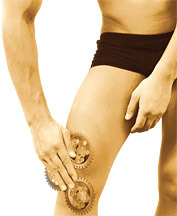Increase strength. Begin with isometric exercises, avoiding full effort but increasing repetitions. Whenever we strengthen the shoulder muscles such as the rotator cuff, always avoid using greater than 5 lbs of weight.
The rotator cuff is a small muscle and more weight does
not mean better outcomes.
Improve proprioception/balance. This is one of the most overlooked parts of shoulder rehab. You can start with push-ups against the wall, progressing to push-ups on a ball against the wall, to push-ups on the floor, to push-ups on unstable surfaces such as a rocker board, vibration platform or gym ball.
Functional exercises. Gradually build up to throwing, lifting, and reaching activities with no pain. Continue with strengthening exercises while increasing functional exercises.
Knee Injury
Examples include osteoarthritis, runner's knee, post-surgery (ACL, meniscus, etc.)
 Ice/heat: Use ice if you notice any swelling during your rehab process. Heat can be used on muscles prior to initiating exercise as long as there is no swelling, and the heat helps you loosen things up so you're better able to do your exercises.
Ice/heat: Use ice if you notice any swelling during your rehab process. Heat can be used on muscles prior to initiating exercise as long as there is no swelling, and the heat helps you loosen things up so you're better able to do your exercises.
Increase flexibility. Assess and find muscles that are tight by comparing one side to the other. Muscles to stretch include the calves, hamstrings, thighs, hip flexors, outer thigh muscles, low back, and gluteals.
For post-surgery patients, regaining range of motion is the most important goal in the beginning. Again, this needs to be done in a pain-free setting, concentrating on more repetitions rather than longer periods of exercise.
Build endurance and strength. I put these two categories together because the goal of any knee rehabilitation program is to strengthen the thigh muscles around the knee joint. Quad sets are good: lying down, straightening the knee, pressing it down into the floor or table while consciously contracting the thighs. So are squats, lunges and knee extensions with light weights, concentrating on increasing repetitions rather than weight or time of contraction.
Improve proprioception/balance. Standing on one foot with eyes open and then closed is effective, progressing to standing on uneven surfaces, such as a rocker board or a vibration platform,and then to standing on one foot while catching a ball or doing upper-body movements.
Functional exercises: Good examples here include lunges, progressing from forward lunges to different angles. Side-to-side movements are also important. Essentially, the knee needs to be stressed carefully in all directions so its stability can be assessed before being discharged into normal activities.
Jasper Sidhu, DC, graduated from Canadian Memorial Chiropractic College in 1994 and opened the Downtown Injury Rehab Centre in Windsor, Ontario, incorporating vibration training into the rehabilitation part of his practice. He is vice president of clinical services for WAVE Manufacturing (www.wavexercise.com).

